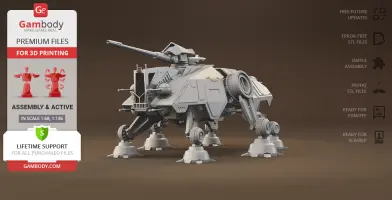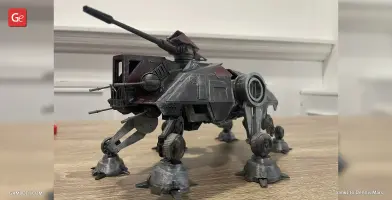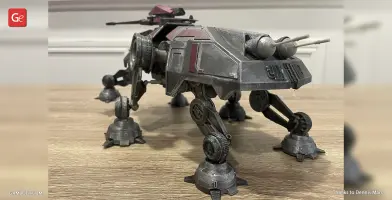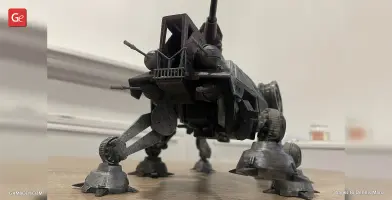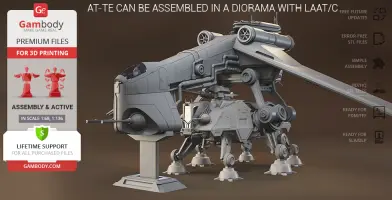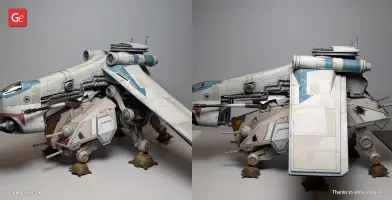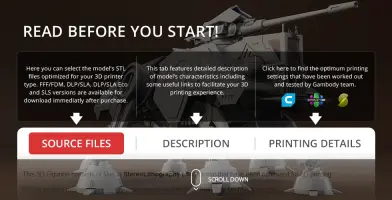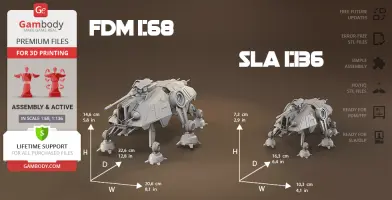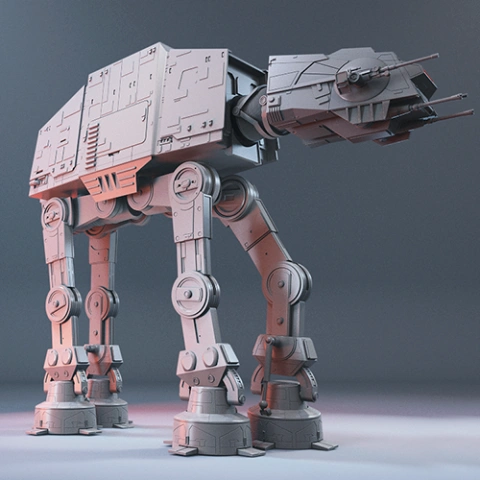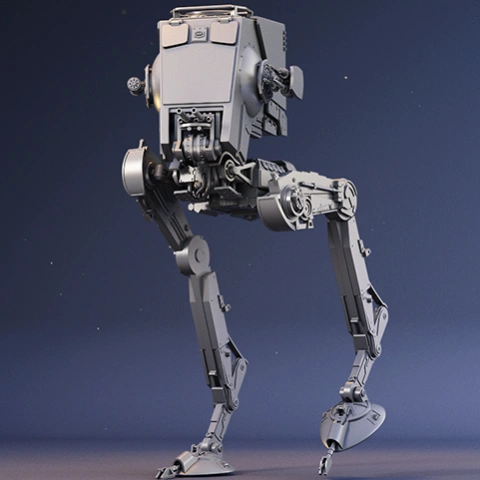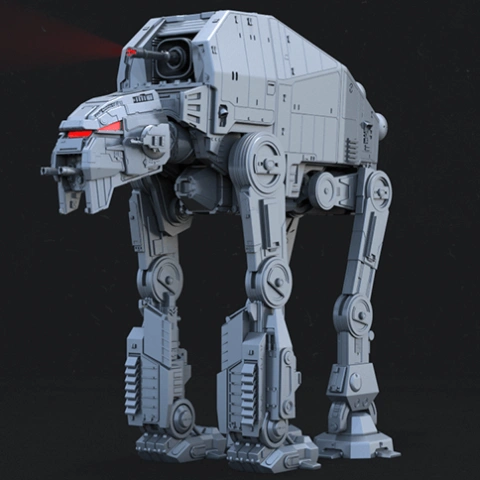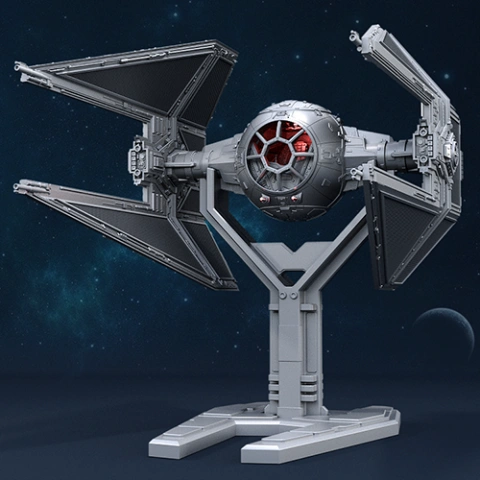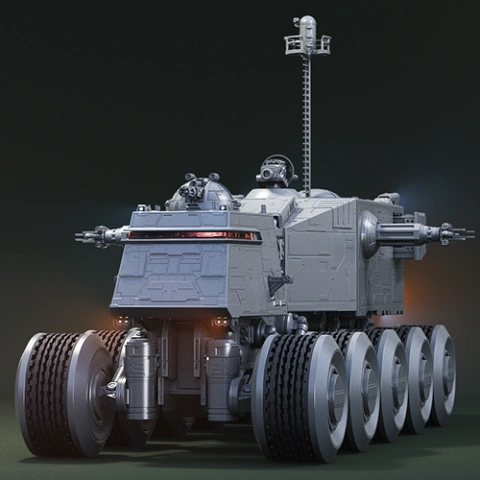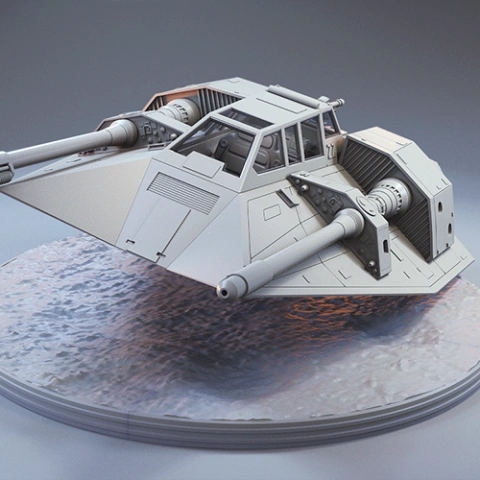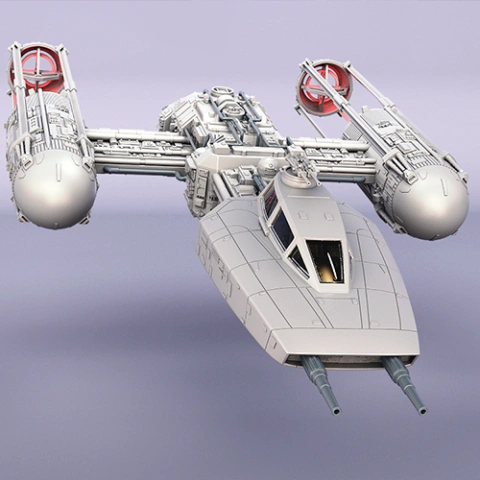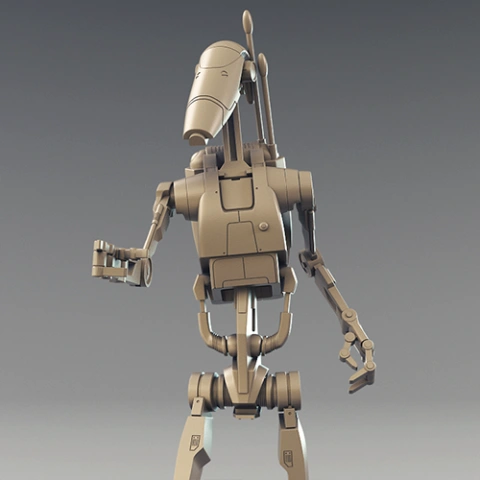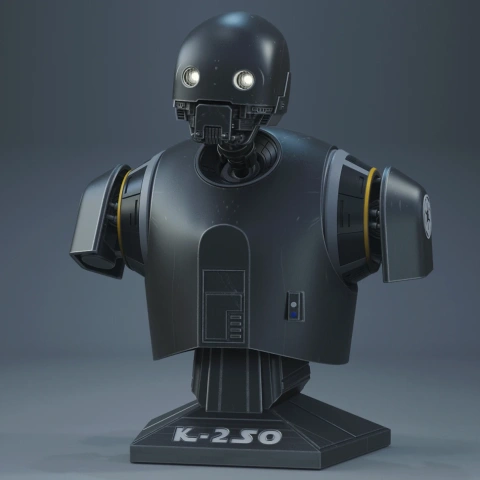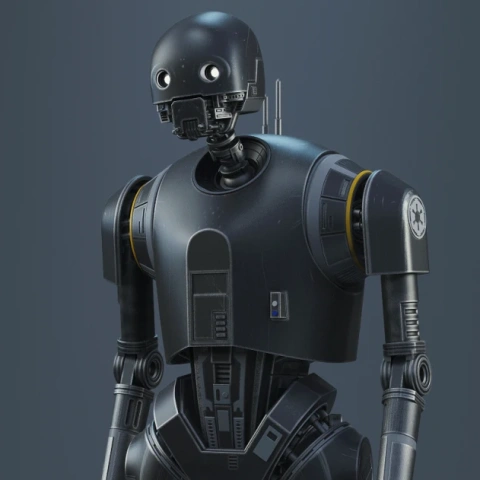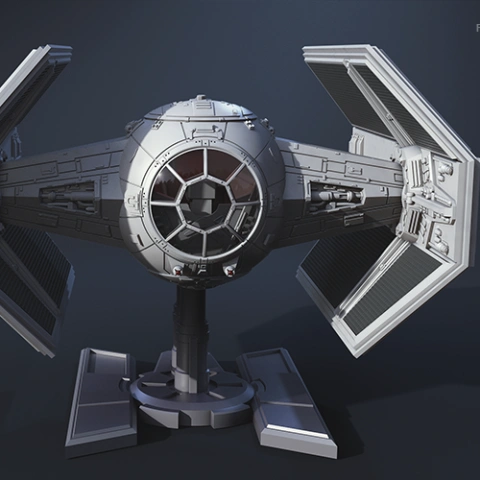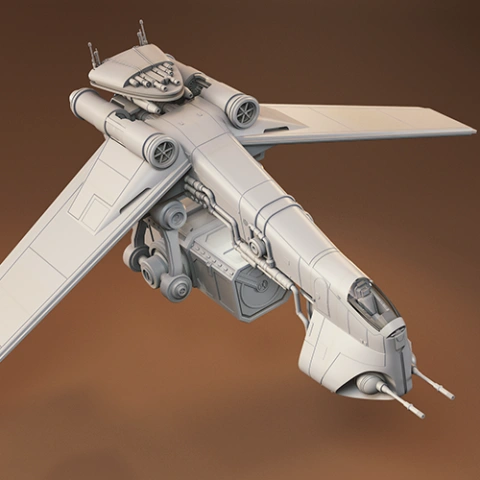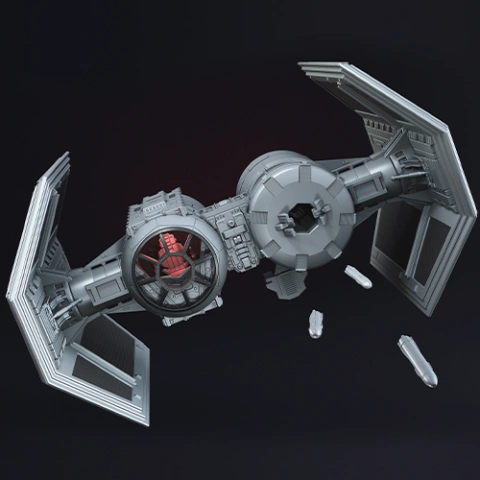Files
3D model format
Stereolithography (.stl)
Total files
Slicer settings
not available
Mesh error check
not specified
Support
Lifetime support from Gambody team
Update requests
not specified
Model versions
FFF/FDM
Assembly method
not specified
Features
DLP/SLA
Assembly method
not specified
Features
Additional details
Part of diorama
No
Special pack included
No
You will get instant access to the STL files of AT-TE Walker 3D Printing Model | Assembly + Active after completing your purchase. Simply add the model to your cart and check out using PayPal, credit or debit card, Apple Pay, Google Pay, Alipay, or other available payment methods.
Watch the assembly video for AT-TE Walker 3D Printing Model | Assembly + Active, and explore more tutorials, behind-the-scenes content, 3D printing timelapses, and painting guides on the official Gambody YouTube channel.
This 3D Model of AT-TE Walker inspired by the Star Wars universe consists of files in StereoLithography (.Stl) format that is optimized for 3D printing.
Before printing the files, we strongly recommend reading the PRINTING DETAILS section.
WHAT WILL YOU GET AFTER PURCHASE?
- 2 versions of AT-TE STL files for FFF/FDM and DLP/SLA - files for all versions are available for download after the purchase
- STL files of high-poly Six Legs Walker 3D Model for 3D printing consist of 101 files
- Sizes:
FFF/FDM: 146 mm tall, 206 mm wide, 326 mm deep
DLP/SLA: 73 mm tall, 103 mm wide, 163 mm deep
- Assembly Manual for FFF/FDM 1.0 and DLP/SLA 1.0 versions in PDF format
- Detailed settings that we provide as a recommendation for Cura, Simplify3D, Slic3r and PrusaSlicer for the best print
- Full technical support from the Gambody Support Team
Detailed information about this 3D printing model is available in the DESCRIPTION section.
Before printing, take a look at Printing Details for recommended settings and tips to achieve better results.
ABOUT THIS 3D MODEL
Nicknamed "six legs", the All Terrain Tactical Enforcer (AT-TE) serves as a multipurpose military ground walker and tank in the Star Wars universe. The menacing design draws inspiration from nature itself and mimics the arctic horny whelmers, the creatures indigenous to the planet Rothana where the vehicle was originally engineered.
This mechanic beast deserved to have its own version for 3D printing, and it was provided by our contributing 3D artist! The vehicle comes with a fascinating level of detail and lots of articulation points introduced by Gambody Team. Thanks to its active design, the AT-TE can move on all of its six sturdy legs and target enemies with the terrific mass-driver cannon and laser cannon turrets. Maybe it will inspire you for a diorama with LAAT/c Gunship dropping the walker off at a ferocious battlefield?
ADAPTATION FOR 3D PRINTING
AT-TE Walker for 3D printing is an active assembly model and its moderation and adaptation for different types of 3D printers took the Gambody team 58 hours in total.
For you to receive the cleanest 3D printing result possible, minimize the amount of filament needed for generated support, and assemble the model with its intended articulation mechanisms, the vehicle was divided into convenient assembly parts.
All assembly parts in the FFF/FDM 1.0 version are provided in STL files in recommended positions that were worked out in order to ensure the smoothness of the details’ surfaces after printing and that the 3D printing beginners won't face difficulties when placing the parts on a build plate. When downloading any model's file you will also receive "Assembly Manual" for FFF/FDM 1.0 and DLP/SLA 1.0 versions in PDF format. We highly recommend that you get acquainted with the “Assembly video” and "Assembly Manual" before getting down to the AT-TE Walker model.
The model is saved in STL files, a format supported by most 3D printers. All STL files for 3D printing have been checked in Netfabb and no errors were shown.
The model’s scale was calculated from the height of the AT-TE Walker which is 9570 mm. The 3D printing model’s chosen scales are 1:68 for the FFF/FDM version and 1:136 for the DLP/SLA version.
VERSIONS' SPECIFICATIONS
FFF/FDM 1.0 version features:
- Contains 71 parts;
- A printed model is 146 mm tall, 206 mm wide, 326 mm deep;
- Can be assembled into a diorama with LAAT/c Gunship;
- The cockpit glass can be lifted to put a pilot in;
- The dorsal turret rotates horizontally and the mass-driver cannon moves up and down;
- Fully articulated laser cannon turrets;
- Removable rear segment reveals the crew compartment;
- Moveable toe actuators;
- Free movement in theankle;
- Free movement of the front and rear legs;
- Complex articulation mechanism of the side legs;
- Tunnels for LED wiring are provided to light up the cockpit, the battery can be stored in the hidden compartment under the dorsal turret;
- All parts are divided in such a way that you will print them with the smallest number of support structures.
DLP/SLA 1.0 version features:
- Contains 30 parts;
- A printed model is 73 mm tall, 103 mm wide, 163 mm deep;
- Can be assembled into a diorama with LAAT/c Gunship;
- The cockpit glass can be lifted to put a pilot in;
- The dorsal turret rotates horizontally and the mass-driver cannon moves up and down;
- Fully articulated laser cannon turrets;
- Removable rear segment reveals the crew compartment;
- Active legs that move on pin connectors;
- Tunnels for LED wiring are provided to light up the cockpit, the battery can be stored in the hidden compartment under the dorsal turret;
- All parts are divided in such a way to fit the build plates and to ensure that support structures are generated where needed.
You can get the model of AT-TE Walker for 3D Printing immediately after the purchase! Just click the green Buy button in the top-right corner of the model’s page. You can pay with PayPal or your credit card.
Watch the tutorial on how to assemble AT-TE Walker3D Printing Model on Gambody YouTube channel.
Also, you may like LAAT/c Gunship3D Printing Model, and other Walkers and Star Wars models for 3D printing.
_______
FAQ:
Where can I print a model if I have no printer?
How to get started with 3D printing?
How to set up my 3D printer?
How to choose right 3D model print bed positioning?
How to paint printed figurine?
Average customer rating (5 reviews)
4.4
Ratings breakdown
Click a star rating to filter reviews
Overall experience
Level of detail in the model
4.4
Model cut quality and assembly guide
4.4
Clarity and accuracy of the model page
4.4
Level of detail in the model
4
Model cut quality and assembly guide
4
Clarity and accuracy of the model page
4
Level of detail in the model
3
Model cut quality and assembly guide
3
Clarity and accuracy of the model page
3
Level of detail in the model
5
Model cut quality and assembly guide
5
Clarity and accuracy of the model page
5
Level of detail in the model
5
Model cut quality and assembly guide
5
Clarity and accuracy of the model page
5
Level of detail in the model
5
Model cut quality and assembly guide
5
Clarity and accuracy of the model page
5
To avoid printing issues and achieve the best quality, we highly recommend applying the following settings:
Generic
Below you can find printing recommendations for Cura, Bambu Studio, Simplify3D, Slic3r and PrusaSlicer software.
Disclaimer: The following printing settings are a recommendation, not an obligation. The parameters can vary depending on the peculiarities of your 3D printer, the material you use, and especially the particular assembly part you are working with. Each part that any model comprises often needs preliminary review, and you are free to tweak the settings the way you find suitable.
Note:
You can scale up the model (downscaling for FFF/FDM 3D printers is not recommended!);
All connectors should be printed at 100% Infill.
Bambu Lab printing recommendations:
These basic 3D printing settings recommendations for beginners were tested in Bambu Studio 1.9.1. Test models were printed on the Bambu Lab A1, Bambu Lab A1 Mini, Creality Ender 3 S1, Anycubic Kobra 2, and Anycubic Vyper using PLA and PETG filaments.
To avoid printing problems, we recommend the following settings:download
Cura printing recommendations:
These are averaged settings which were tested in the Cura 5.2.1 slicer. Test models were printed on Anycubic Vyper, Creality Ender 3 Pro with PLA filament.
To avoid printing problems, we recommend the following settings:download
Simplify3D printing recommendations:
These are averaged settings which were tested in the Simplify3D 5.0.0 slicer. Test models were printed on Anycubic Vyper, FLSUN v400, Ender3 S1 with PLA filament.
To avoid printing problems, we recommend the following settings:download
Slic3r printing recommendations:
These basic 3D printing settings recommendations for beginners were tested in Slic3r 1.3.0 software. Test models were printed on Ultimaker 2, Creality Ender 3, Creality Cr-10S pro v2, Anycubic I3 Mega, Anycubic I3 MegaS, Anycubic Vyper with PLA and PetG filaments.
To avoid printing problems, we recommend the following settings:download
PrusaSlicer printing recommendations:
These basic 3D printing settings recommendations for beginners were tested in PrusaSlicer 2.3.1. Test models were printed on Ultimaker 2, Creality Ender 3, Creality Cr-10S pro v2, Anycubic I3 Mega, Anycubic I3 MegaS, Anycubic Vyper with PLA and PETG filaments.
To avoid printing problems, we recommend the following settings:download
